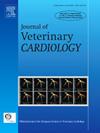Intra-operative use of transesophageal echocardiography in dogs undergoing interventional procedures for pulmonic stenosis: a case series
IF 1.3
2区 农林科学
Q2 VETERINARY SCIENCES
引用次数: 0
Abstract
Six dogs were presented for interventional treatment of pulmonic stenosis (balloon valvuloplasty or pulmonary stent implantation). Intra-operative transesophageal echocardiography was performed for subjective pulmonary valve assessment and to measure the transpulmonary pressure gradient. Balloon valvuloplasty was performed in two dogs; the remaining four dogs underwent pulmonary stent implantation. The reduction in pressure was assessed after balloon inflation/stent deployment by right heart catheterization and transesophageal echocardiography. In two patients, complete catheterization was not performed, and success was based solely on a reduction in the pressure gradient measured by transesophageal echocardiography. The procedure was completed successfully in all six dogs, with reduction in pressure measured by catheterization ranging from 47.0% to 96.8% (median: 78.6%) in four dogs and 47.3%–85.2% (median: 80.9%) measured by transesophageal echocardiography in all six dogs. No complications associated with transesophageal echocardiography were observed. In this case series, transesophageal echocardiography allowed subjective assessment of the pulmonic valve leaflets and measurement of annular diameter and transpulmonary pressure gradient. The reduction in transpulmonary pressure gradient seen with transesophageal echocardiography was comparable to the reduction documented on catheterization. Further studies are indicated to objectively assess the agreement between transesophageal echocardiography and catheterization measurements, but in these patients, transesophageal echocardiography allowed increased confidence in procedural success.
在接受肺动脉狭窄介入手术的犬只术中使用经食道超声心动图:一个病例系列
本文介绍了6只狗进行肺动脉狭窄的介入治疗(球囊瓣膜成形术或肺支架植入术)。术中行经食管超声心动图对肺动脉瓣进行主观评估,并测量经肺压力梯度。2只犬行球囊瓣膜成形术;其余4只狗接受了肺支架植入。通过右心导管和经食管超声心动图评估球囊膨胀/支架置入后压力的降低。在两名患者中,没有进行完全的导管置入,成功仅仅是基于经食管超声心动图测量的压力梯度的降低。所有6只狗都成功完成了手术,4只狗通过导管测量的压力降低了47.0%至96.8%(中位数:78.6%),6只狗通过经食管超声心动图测量的压力降低了47.3%至85.2%(中位数:80.9%)。经食管超声心动图检查无并发症。在本病例系列中,经食管超声心动图可以对肺动脉瓣小叶进行主观评估,并测量肺动脉环直径和经肺压力梯度。经食管超声心动图显示的经肺压力梯度的降低与导管置入术记录的降低相当。进一步的研究表明,客观地评估经食管超声心动图和导管测量之间的一致性,但在这些患者中,经食管超声心动图增加了手术成功的信心。
本文章由计算机程序翻译,如有差异,请以英文原文为准。
求助全文
约1分钟内获得全文
求助全文
来源期刊

Journal of Veterinary Cardiology
VETERINARY SCIENCES-
CiteScore
2.50
自引率
25.00%
发文量
66
审稿时长
154 days
期刊介绍:
The mission of the Journal of Veterinary Cardiology is to publish peer-reviewed reports of the highest quality that promote greater understanding of cardiovascular disease, and enhance the health and well being of animals and humans. The Journal of Veterinary Cardiology publishes original contributions involving research and clinical practice that include prospective and retrospective studies, clinical trials, epidemiology, observational studies, and advances in applied and basic research.
The Journal invites submission of original manuscripts. Specific content areas of interest include heart failure, arrhythmias, congenital heart disease, cardiovascular medicine, surgery, hypertension, health outcomes research, diagnostic imaging, interventional techniques, genetics, molecular cardiology, and cardiovascular pathology, pharmacology, and toxicology.
 求助内容:
求助内容: 应助结果提醒方式:
应助结果提醒方式:


